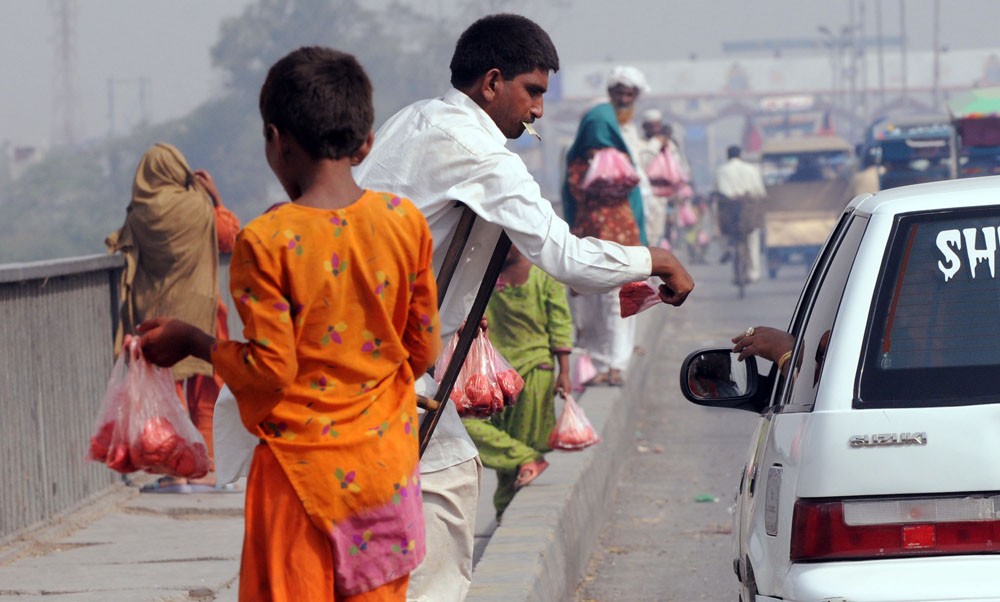
Roadside vendors of sadka gosht, especially on the Canal, are becoming a daily nuisance for the ongoing traffic. They are also destroying the ecosystem

The endless stalls of meat disposables, popularly known as ‘cheel gosht,’ along the canal are a common sight. For the vendors, it is daily business but for the motor vehicles, particularly bikes, plying on the freeway, this spells horror.
The stalls are set up strategically at points where the traffic accumulates in general. Those interested in making a purchase suddenly pull to a side, disturbing the flow of the traffic. They pick up packets of what they call ‘sadka gosht’ and throw them in the air for birds of prey. The act, it is believed, wards off any untoward incident for them.
The story doesn’t end here. As just as the meat pieces are hurled in the air, the birds that were lurking behind the huge trees and electricity poles, waiting to pounce, make a dash towards them, sometimes diving as low as the traffic on the road. This causes not just distraction but also accidents, as the birds hit right into the car windscreens, as a result of which the vehicle drivers lose control.
Not long ago, the City District Government together with LDA launched a campaign against such vendors, in the wake of the rising number of accidents on Canal Road. However, nothing came of it.
Presently, cheel gosht vendors can be spotted in considerable numbers along the Canal, right from Jallo to Thokar Niaz Baig and, on the other side, from Azadi Chowk to Shahdara Morr. They also pile up on The Mall, around Bagh-e-Jinnah.
The sadka gosht sellers -- adults as well as children -- are usually riding the bicycles, carrying meat in plastic bags or, at times, wooden boxes.
The practice is also damaging the ecosystem. According to renowned environmentalist and Professor of Zoology at the Punjab University Dr Zulfiqar Ali, "Our research students can’t find the birds that used to exist in Lahore sometime ago. With the rise in numbers of scavenger birds like kites and vultures, the insect-eating birds are becoming extinct.
"There was a time when Lahore was home to over 200 bird species but today these have been reduced to mere 90," Ali says. He cites urbanisation, the cutting of native trees and the rising number of kites as chief reasons for this.
"Fifty per cent of the extinct birds were those that ate insects. For instance, a robin eats mosquitoes in amounts equal to its body weight. Just as some fish eat dengue larvae, the insectivorous birds also eat mosquitoes. But as they decreased in number, the dengue virus is on the rise."
The main reason for increasing number of kites, Ali says, is the sadka gosht which the people throw at them, and the vendors are responsible for dishing it out, particularly on different important roads of the city.
Further, he reveals that the vendors mix food colour in the meat in order to make it more visible to the birds of prey. "This colour, or chemical, is toxic and can make the birds sick and, sometimes, die.
"The putrefied bodies of these dead birds pollute the air. Besides, when the healthy animals and birds feed on them, they also fall sick."
Dr Zulfikar Ali believes the tree-lined Canal Rd is not a suitable habitat for smaller birds. "These are exotic trees, imported from Australia. They can usually not hold the birds’ nests for long. Secondly, bigger species such as kites scare the small birds away."
Roadside stalls of sadka gosht have become profitable business overtime. On an average, a vendor makes somewhere between Rs500-600 a day, from the meat disposables he has got from the butchers’ shop free of cost.
When prompted, a vendor admits he has to grease the palm of the raiding team members in order to continue with their business. "It’s a monthly sum," he declares.